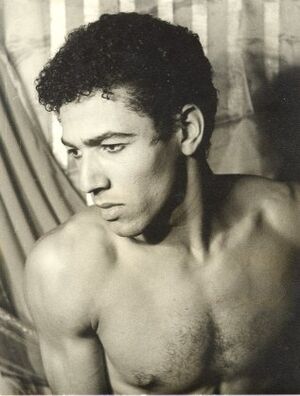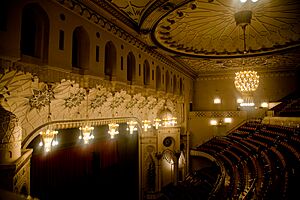Francisco Moncion facts for kids
Quick facts for kids
Francisco Moncion
|
|
|---|---|

Francisco Moncion
Photo by Carl Van Vechten, 1947 |
|
| Born | July 6, 1918 La Vega, Dominican Republic
|
| Died | April 1, 1995 (aged 76) Woodstock, New York, US
|
| Occupation | Danseur, Choreographer |
| Years active | 1942–1983 |
Francisco Moncion (born July 6, 1918 – died April 1, 1995) was a very important dancer and choreographer. He was one of the first members of the famous New York City Ballet. During his long career, which lasted about 40 years, he performed in many major ballets. He worked with famous choreographers like George Balanchine and Jerome Robbins. Besides dancing, he also created his own ballets and was a skilled painter.
Contents
Becoming a Dancer: Early Life and Training
Francisco Moncion was born in La Vega, a city in the Dominican Republic. When he was about four years old, his family moved to the United States. He didn't start dancing until he was 20 years old. This happened almost by chance!
In 1938, he received a special offer. It was a scholarship to the new School of American Ballet. This school was looking for male students. Francisco accepted the offer. Soon, he was taking dance classes with famous teachers. These included Balanchine, Pierre Vladimiroff, and Anatole Oboukoff. He learned the strict rules of classical ballet.
In 1942, while still a student, he danced in a ballet called Ballet Imperial. It was part of a show in New York City. But World War II was happening in Europe. So, Francisco decided to join the U.S. Army. After two years of serving his country, he returned to New York. That's when his professional dance career truly began.
A Career in Ballet: Professional Life
Francisco Moncion's first professional dance job was on Broadway. He danced as a "gypsy" in a show called The Merry Widow. The dances for this show were created by Balanchine. After this show closed in 1944, he joined a group called Ballet International. He quickly became a main dancer.
Later that year, he performed in two big ballets. He played the main character, Sebastian, in Edward Caton's Sebastian. He also played Tristan in Léonide Massine's Mad Tristan. This ballet was very unique, with amazing designs by Salvador Dalí. A famous dance critic, Edwin Denby, praised Francisco's performance. He said Francisco was a "very fine dancer" and "exceptionally imaginative."
After this, Moncion danced briefly with another company. Then, in 1947, he became a founding member of Ballet Society. This company was started by Balanchine and Lincoln Kirstein. Later, Ballet Society became the famous New York City Ballet. Francisco spent four decades dancing with these companies. He created many important roles and was part of many historic performances.
At the very first show of the New York City Ballet on October 11, 1948, he danced in all three ballets! These were Concerto Barocco, Orpheus, and Symphony in C. Many years later, he also performed in a new ballet called Tchaikovsky Suite No. 2.
Key Roles Francisco Moncion Created
Francisco Moncion helped create many roles in new ballets. Here are some of the most important ones. Most were choreographed by George Balanchine.
- 1944. Sebastian. He played Sebastian.
- 1944. Mad Tristan. He played Tristan.
- 1946. The Four Temperaments. He danced in Theme 3. This was at the first show of Ballet Society.
- 1947. Divertimento. He was a main dancer.
- 1948. The Triumph of Bacchus and Ariadne. He played Midas.
- 1948. Concerto Barocco. He was a main dancer.
- 1948. Orpheus. He played the Dark Angel. This was one of his most famous roles.
- 1948. Symphony in C. He danced in the second movement.
- 1949. Firebird. He played Prince Ivan.
- 1949. Jinx. He was a main dancer.
- 1950. The Age of Anxiety. Choreographed by Jerome Robbins. He was a main dancer.
- 1951. La Valse. He played Death.
- 1952. Picnic at Tintagel. He played The Husband (King Mark).
- 1953. Afternoon of a Faun. Choreographed by Jerome Robbins. He played The Boy.
- 1954. Opus 34. He danced in "The First Time."
- 1954. The Nutcracker. He danced the Coffee (Arabian Dance).
- 1954. Ivesiana. He danced in "Central Park in the Dark."
- 1959. Episodes. He danced in "Ricercata."
- 1960. The Figure in the Carpet. He played The Duke of Grenada.
- 1962. A Midsummer Night's Dream. He played Theseus, Duke of Athens.
- 1965. Don Quixote. He played Merlin.
- 1967. Jewels, part 1, Emeralds. He was the second lead dancer.
- 1970. In the Night. Choreographed by Jerome Robbins. He was a main dancer.
- 1972. Pulcinella. He played the Devil.
- 1982. Noah and the Flood. He was a main dancer.
Moncion's Diverse Artistic Talents
Francisco Moncion was known for being able to dance many different kinds of roles. He might not have been the typical "prince" in ballets, but he was amazing in many other parts.
For example, he was very energetic in Balanchine's dances for The Chocolate Soldier. He was a gentle partner in Jerome Robbins's Afternoon of a Faun. He showed powerful emotions as the main character in Balanchine's Prodigal Son. He was also very funny as The Husband in Robbins's The Concert. Most famously, he was mysterious and beautiful as the Dark Angel in Orpheus. This role is often remembered as his best.
Moncion's Own Choreographies
In the 1950s and 1960s, Francisco Moncion also created his own ballets. He made four for the New York City Ballet and two for other companies.
- 1955. Jeux d'Enfants. He worked with Balanchine on this one.
- 1957. Pastorale.
- 1959. Choros No. 7.
- 1960. Les Biches.
- 1965. Honegger Concertino. This was for the Pennsylvania Ballet.
- 1966. Night Song. This was for the Washington Ballet.
Later Life and Legacy
Francisco Moncion's family name is famous in the Dominican Republic. They are connected to General Benito Monción, a military officer from the 1800s. In 1947, Francisco Moncion became a citizen of the United States.
After he stopped dancing in 1983, Moncion enjoyed his retirement. He lived in Woodstock, New York. He spent his time painting with oil paints, which he was very good at. His paintings were even shown in art exhibitions in New York. Francisco Moncion passed away from cancer at his home when he was 76 years old.
See also
 In Spanish: Francisco Moncion para niños
In Spanish: Francisco Moncion para niños




